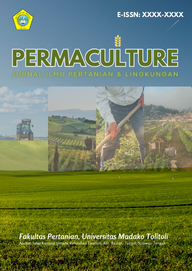Strategy to Increase the Growth and Productivity of Red Onions (Allium ascalonicum L.) through a Combination of Mulch and Chicken Manure
DOI:
https://doi.org/10.1234/pmr.v1i2.1385Keywords:
Shallots, organic mulch, plastic mulch, manureAbstract
Shallots (Allium ascalonicum L.) are one of the important horticultural commodities in Indonesia whose productivity is greatly influenced by cultivation techniques, especially mulch and organic fertilizer. This study was conducted to increase the growth and yield of shallots through various types of mulch and doses of chicken manure. The study was conducted in the Faculty of Agriculture practice field, Madako University, Tolitoli, Tolitoli Regency, Central Sulawesi, for three months, from February to April 2024. The design used was a two-factor Randomized Block Design (RBD), namely the type of mulch (M0: without mulch, M1: rice husk charcoal, M2: plastic mulch) and the dose of chicken manure (K0: without fertilizer, K1: 10 tons/ha, K2: 20 tons/ha), each with three replications. Data were analyzed using analysis of variance (ANOVA), followed by the Least Significant Difference (LSD) test at the 5% level. The results showed that the plastic mulch treatment (M2) significantly affected the fresh weight of tubers with leaves, the fresh weight of tubers without leaves, and the number of tubers. Meanwhile, a dose of 20 tons/ha of chicken manure (K2) significantly affected the fresh weight of tubers both with and without leaves. The interaction between the two factors was insignificant, so their effects were independent. Thus, increasing the dose of chicken manure (K2) still produced the highest yield regardless of the type of mulch used.
References
Adnan, A., Sondakh, R. C., & Damayanti, I. (2025). Kombinasi Perlakuan Pupuk Organik Dengan Pupuk Npk Phonska Terhadap Pertumbuhan Padi (Oryza sativa L) Varietas Inpari 32. Tolis Ilmiah: Jurnal Penelitian, 7(1), 48–54. https://doi.org/10.56630/tolis.v7i1.826
Adnan, Sondakh, R. C., & Alfin, M. (2023). Pengaruh Kombinasi Mulsa dan Pupuk Kandang terhadap Tanaman Bawang Merah. Journal of Multi Disciplinary Sciences, 2(2), 61–71. https://doi.org/10.62394/scientia.v2i2.55
Ahmad, F., Sondakh, R., & Budiarto, E. (2021). Aplikasi microorganisme lokal akar bambu terhadap kualitas tanaman jagung tongkol. JAGO TOLIS : Jurnal Agrokompleks Tolis, 1(3), 66–70. https://doi.org/10.56630/jago.v1i3.165
Ayu, N. G., Rauf, A., & Samudin, S. (2016). Pertumbuhan Dan Hasil Dua Varietas Bawang Merah (Allium ascalonicum L.) Pada Berbagai Jarak Tanam. E-J. Agrotekbis, 4(5), 530–536.
Battong, U., Sari, K. R., & Nasrah, N. (2020). Pengaruh Konsentrasi Pupuk Organik Cair Nasa dan Pemberian Mulsa Organik Terhadap Pertumbuhan dan Hasil Bawang Merah (Allium cepa L.). AGROVITAL : Jurnal Ilmu Pertanian, 5(1), 21–24. https://doi.org/10.35329/agrovital.v5i1.640
Hayatudin, H., & Adnan, A. (2021). Pengaruh Berbagai Jenis Mulsa dan Dosis Pupuk Kandang Kambing Terhada Pertumbuhan dan Hasil Tanaman Bawang Merah (Allium Cepa). JAGO TOLIS : Jurnal Agrokompleks Tolis, 1(3), 74–80. https://doi.org/10.56630/jago.v1i3.167
Junaidi. (2022). Respon Tanaman Jagung Manis (Zea Mays Saccharata Sturt) Terhadap Jumlah Benih Per Lubang dan Pemberian Pupuk Kandang Ayam. Jurnal Multidisiplin Madani, 2(6), 2827–2846. https://doi.org/10.55927/mudima.v2i6.534
Kahar, K. (2021). Respon Pertumbuhan Dan Hasil Beberapa Varietas Tanaman Tomat (Solanum lycopersicum L.) Akibat Pemberian Jenis Pupuk Kandang. JAGO TOLIS : Jurnal Agrokompleks Tolis, 1(3), 60–65. https://doi.org/10.56630/jago.v1i3.164
Kasim, N., Hayatudin, H., & Junaidi, J. (2022). Pengaruh Interval Waktu Pembumbunan Dan Dosis Pupuk Kandang Ayam Terhadap Pertumbuhan Dan Hasil Kacang Tanah (Arachis hypogeae L). JAGO TOLIS : Jurnal Agrokompleks Tolis, 2(3), 50–55. https://doi.org/10.56630/jago.v2i3.235
Lasmini, S. A., Wahyudi, I., & Rosmini. (2018). Aplikasi Mulsa dan Biokultur Urin Sapi terhadap Pertumbuhan dan Hasil Bawang Merah. Jurnal Hortikultura Indonesia, 9(2), 103–110. https://doi.org/10.29244/jhi.9.2.103-110
Mabel, J. M., & Tuhuteru, S. (2020). Pemanfaatan Limbah Rumah Tangga Sebagai Kompos Pada Tanaman Bawang Merah (Allium cepa var. Agregatum L.). Agritrop : Jurnal Ilmu-Ilmu Pertanian (Journal of Agricultural Science), 18(1). https://doi.org/10.32528/agritrop.v18i1.3030
Pauza, N. M., Niswati, A., Dermiyati, D., & Yusnaini, S. (2016). Pengaruh Sistem Olah Tanah Dan Aplikasi Mulsa Bagas Terhadap Biomassa Karbon Mikroorganisme Tanah (C-Mik) Pada Lahan Pertanaman Tebu (Saccharum officinarum L.) TAHUN KE-5. Jurnal Agrotek Tropika, 4(2), 158–163. https://doi.org/10.23960/jat.v4i2.1866
Usman, A. I. (2021). Pengaruh Penggunaan Pupuk Kandang Ayam Dan Kcl Terhadap Pertumbuhan Dan Hasil Tanaman Bawang Merah (Allium ascalonicum L) Varietas Topo Di Inceptisol Ternate. Cannarium, 19(1), 121–126. https://doi.org/10.33387/cannarium.v19i1.3013

















